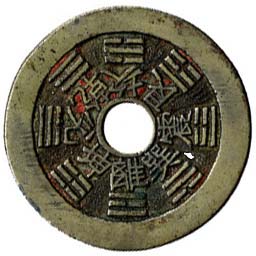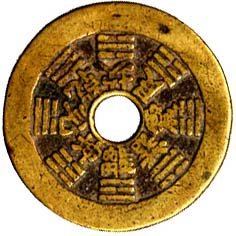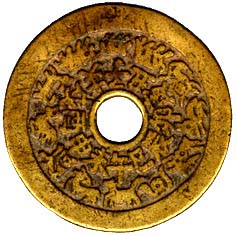I believe this charm was cast in the later era of the Republic, because it was made of what commonly known as white copper [I think may be the alloy contained with more tin.] with its distinct theme designs and diversified artistic styles. This charm is much worn, and it was repaired with some waxy material, but I don't mind, as I am fond of its modern appearance.
The obverse of this coin is inscribed with the "Eight Trigrams" in the Later Heaven arrangement.
The Eight Trigrams is come from  "I Ching" or the "Book of Changes" and the eight cyclical characters "I Ching" or the "Book of Changes" and the eight cyclical characters  . "I Ching" is the earliest philosephical work extant in China. It is also used to divine the unknown or the future by supernatural means by the Chinese over three thousand years. . "I Ching" is the earliest philosephical work extant in China. It is also used to divine the unknown or the future by supernatural means by the Chinese over three thousand years.
As it is full of images and symbols, this book has been tinged with mysticism. Ancient Chinese had been confused by the patterns of change that govern the world. As I know that western people in present day also show wide interest in this anonymous masterpiece.
The reverse of this coin is inscribed with the 12 horary characters arranged in a circle at the aperture, and at the outer edge are the corresponding symbolic animals. The symbolism of the eight characters and their corresponding trigrams on the obverse represent 8 directions and 8 kinds of the phenomena of nature.
| Range |
| Represent |
|---|
 "Ch'ien" "Ch'ien" | - | Northwest / Heaven |
 "Kun" "Kun" | - | Southwest / Earth |
 "Chen" "Chen" | - | East / Thunder |
 "Sun" "Sun" | - | Southeast / Wind |
 "Kan" "Kan" | - | North / Moving water |
 "Li" "Li" | - | South / Fire |
 "Ken" "Ken" | - | Northeast / Mountains |
 "Tui" "Tui" | - | West / Still water |
|
|
|
|
|
The function of this brassy charm is the same as the previous one, but the design is completely different. It looks much older than the above one. The inscriptions on the surfaces had worn away naturally, the patterns were difficult to read, showing that this charm was consumed by constant use. I think this charm was cast in the later Ch'ing dynasty, if I pushed it to the limit. But it is not important, as I just want to talk briefly about the Earthly Branches and the animals of the zodiac on the reverse.
Do you hear about the Chinese chronological cycle of sixty years? It is formed by the combination of 2 sets of characters in a particular way. They are  "The Heavenly Stems" whcih has 10 characters and "The Heavenly Stems" whcih has 10 characters and  "The Earthly Branches" which has 12 characters. The 1st of these "Stems" and the 1st of these "Branches" are putting together to form the first year, then continuing until the stems come to an end. The 11th "Branches" is put together with the 1st "Stems" (use again) to form the 11th year, and so the whole number of different combinations in this way is sixty, one complete cycle. "The Earthly Branches" which has 12 characters. The 1st of these "Stems" and the 1st of these "Branches" are putting together to form the first year, then continuing until the stems come to an end. The 11th "Branches" is put together with the 1st "Stems" (use again) to form the 11th year, and so the whole number of different combinations in this way is sixty, one complete cycle.
Each of the 12 Earthly Branches is regarded as denoting one of 12 animals. The 12 animals, mentioned in the order of the horary characters to which they refer, are these: Rat, cow, tiger, rabbit, dragon, snake, horse, sheep, monkey, cock, dog, and boar. Chinese is said to be born under a certain animal, or to "belong" to a certain animal. Chinese usually express this idea by saying "his animal is the dragon," or "her animal is the tiger," as the case my be. The phraseology simply means that he was born during the year when the character corresponding to the "dragon" or to the "tiger" enters into the term which denotes that year, according to the chronological cycle of sixty. Chinese know much about these, though they no longer believe it is of any significance to their lives.
|
 or "Yan Sheng Zhu"
or "Yan Sheng Zhu" , other more popular names for charm are "Hua Chien"
, other more popular names for charm are "Hua Chien"  [flower coin] or "Wan Chien"
[flower coin] or "Wan Chien"  [play coin]. They were used as amulet against evil and not as money, so that the Chinese collectors seldom collect them. It is very difficult to trace
the history and developments of Hua Chien, but the mintage of Hua Chien began as early as the Han Dynasty. Actually, those we can see were cast during the recent 100 years. That type of coins normally bear auspicious characters on the obverse side. On the reverse side were various designs of double fish, dragon and phoenix, stars, sword, tortoise and snakes, etc. Hua Chien is only used as an ornament or an amulet to expel or keep away evil spirits and unpropitious influences and not as money.
[play coin]. They were used as amulet against evil and not as money, so that the Chinese collectors seldom collect them. It is very difficult to trace
the history and developments of Hua Chien, but the mintage of Hua Chien began as early as the Han Dynasty. Actually, those we can see were cast during the recent 100 years. That type of coins normally bear auspicious characters on the obverse side. On the reverse side were various designs of double fish, dragon and phoenix, stars, sword, tortoise and snakes, etc. Hua Chien is only used as an ornament or an amulet to expel or keep away evil spirits and unpropitious influences and not as money.


 "I Ching" or the "Book of Changes" and the eight cyclical characters
"I Ching" or the "Book of Changes" and the eight cyclical characters  . "I Ching" is the earliest philosephical work extant in China. It is also used to divine the unknown or the future by supernatural means by the Chinese over three thousand years.
. "I Ching" is the earliest philosephical work extant in China. It is also used to divine the unknown or the future by supernatural means by the Chinese over three thousand years.  "Ch'ien"
"Ch'ien"  "Kun"
"Kun"  "Chen"
"Chen"  "Sun"
"Sun"  "Kan"
"Kan"  "Li"
"Li"  "Ken"
"Ken"  "Tui"
"Tui" 

 "The Heavenly Stems" whcih has 10 characters and
"The Heavenly Stems" whcih has 10 characters and  "The Earthly Branches" which has 12 characters. The 1st of these "Stems" and the 1st of these "Branches" are putting together to form the first year, then continuing until the stems come to an end. The 11th "Branches" is put together with the 1st "Stems" (use again) to form the 11th year, and so the whole number of different combinations in this way is sixty, one complete cycle.
"The Earthly Branches" which has 12 characters. The 1st of these "Stems" and the 1st of these "Branches" are putting together to form the first year, then continuing until the stems come to an end. The 11th "Branches" is put together with the 1st "Stems" (use again) to form the 11th year, and so the whole number of different combinations in this way is sixty, one complete cycle.